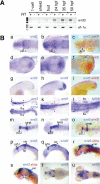Zebrafish wnt3 is expressed in developing neural tissue
- PMID: 19452545
- PMCID: PMC3086138
- DOI: 10.1002/dvdy.21977
Zebrafish wnt3 is expressed in developing neural tissue
Abstract
Wnt signaling regulates embryonic patterning and controls stem cell homeostasis, while aberrant Wnt activity is associated with disease. One Wnt family member, Wnt3, is required in mouse for specification of mesoderm, and later regulates neural patterning, apical ectodermal ridge formation, and hair growth. We have identified and performed preliminary characterization of the zebrafish wnt3 gene. wnt3 is expressed in the developing tailbud and neural tissue including the zona limitans intrathalamica (ZLI), optic tectum, midbrain-hindbrain boundary, and dorsal hindbrain and spinal cord. Expression in these regions suggests that Wnt3 participates in processes such as forebrain compartmentalization and regulation of tectal wiring topography by retinal ganglia axons. Surprisingly, wnt3 expression is not detectable during mesoderm specification, making it unlikely that Wnt3 regulates this process in zebrafish. This lack of early expression should make it possible to study later Wnt3-regulated patterning events, such as neural patterning, by knockdown studies in zebrafish.
(c) 2009 Wiley-Liss, Inc.
Figures



References
-
- Barrow JR, Howell WD, Rule M, Hayashi S, Thomas KR, Capecchi MR, McMahon AP. Wnt3 signaling in the epiblast is required for proper orientation of the anteroposterior axis. Dev Biol. 2007;312:312–320. - PubMed
-
- Bovolenta P, Rodriguez J, Esteve P. Frizzled/RYK mediated signalling in axon guidance. Development. 2006;133:4399–4408. - PubMed
-
- Braun MM, Etheridge A, Bernard A, Robertson CP, Roelink H. Wnt signaling is required at distinct stages of development for the induction of the posterior forebrain. Development. 2003;130:5579–5587. - PubMed
-
- Buckles GR, Thorpe CJ, Ramel MC, Lekven AC. Combinatorial Wnt control of zebrafish midbrain-hindbrain boundary formation. Mech Dev. 2004;121:437–447. - PubMed
Publication types
MeSH terms
Substances
Grants and funding
LinkOut - more resources
Full Text Sources
Molecular Biology Databases
Research Materials

